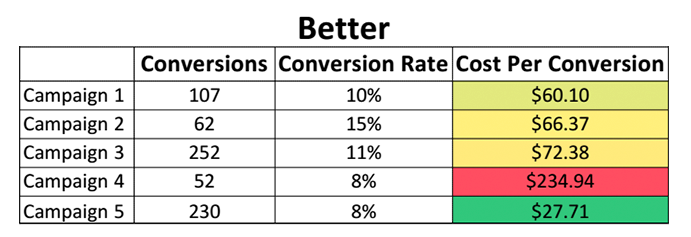Many car models come in different trim levels. For example many Toyota models come in LE, XLE, or Limited – every time you move up a trim level your vehicle will come with a bunch of new features and benefits. So, what does this have to do with which PPC metrics really matter you ask?
Well, there are a lot of ways to gauge your PPC campaign performance. Over the years we’ve seen people analyzing their PPC campaigns in three big buckets (good, better, best) and just like in the aforementioned vehicle trim levels as you move up you gain a better understanding of the ROI of your PPC investments. So let’s go through these three buckets:
The “LE” (good)
These are people who default to what we consider “kinda fluffy” metrics like cost-per-click (CPC) and Cost to figure out which of their campaigns are working most effectively. We call these traffic focused metrics. Here is an example:
Your a B2B company that sells some sort of filtering component/widget and your average customer is worth $3,500 in revenue with a gross margin of 50%. If you are using “fluffy” metrics you’ll probably be looking at data like this:
Here we see that Campaign 5 has the most clicks, the best CTR and the lowest CPC – which would indicate that it is performing the best and Campaign 4 is performing the worst. The problem is that these metrics can’t help us understand if the traffic is actually contributing to a company’s bottom line.
The “XLE” (better)
These are people who have set up conversion tracking. Conversion focused metrics are a lot more valuable because they can help you identify top performing campaigns based on Cost Per Lead. Now the data you can analyze looks a lot like this:
Again, it looks like Campaign #5 is out performing the others with the second most Conversions and by far the lowest Cost Per Conversion. If this is where your data trail ended, you’d probably make the decision to shut off Campaign #4 all together because it isn’t driving a lot of Conversions and its Cost Per Conversion is almost 10 times as much as Campaign #5.
The “Limited” (best)
These are people who not only have conversion tracking set up but they are cross referencing this data with their CRM and can attribute actual revenue back to the campaigns they are running. This is the most meaningful data because it shows you which campaigns are positively impacting the company’s bottom line.
You’ll understand which campaigns, ads and keywords are actually generating money for your company. We’re talking “from click-to close” – measuring revenue on a per-lead basis. So now your data looks something like this:
Here you begin to see that Campaign #4 (which was the worst performing in the “good” & “better” scenario) is actually driving the most revenue and has the best ROI.
Knowing how valuable each conversion is allows you to maximize revenue by tweaking and making changes to the campaigns that will impact the bottom line. In this case you’d likely increase the budget to Campaign #4 and possibly #5. You could also try improving the ads or landing pages for Campaign #3 because it is driving a lot of traffic and conversions but is way behind when seen through the ROI lens.
So, get busy upgrading your conversion tracking and CRM data integration – then you’ll be tracking which PPC metrics really matter!







